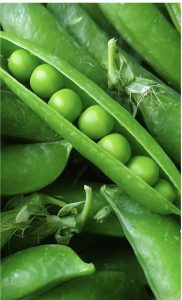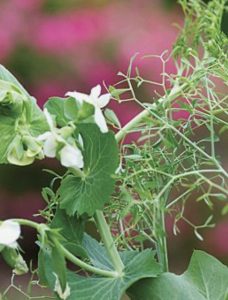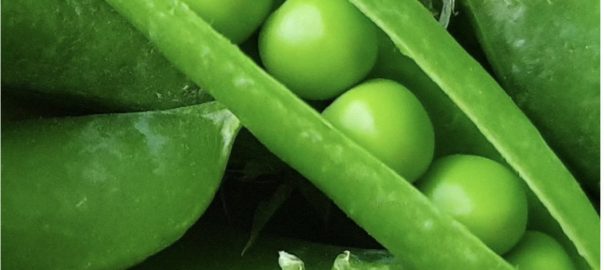Grow Me Now!
May
Pop in Some Peas!
Shelling-peas take up quite a lot of space in relation to the harvest they return, so deciding whether or not to grow them in the tunnelhouse in the off season can be fraught. However, sugar snap and snow peas are a different story because their entire pod is eaten, which increases their return for the valuable space they occupy. ‘Snaps’ and ‘snows’ sown in autumn will produce pods in early to mid spring in cooler parts of the country, and earlier in mild regions. When the vines are spent, they can be dug back into the ground provided they are disease-free.

Source
Outside of spring, it can be infuriatingly difficult to locate sugar snap and snow pea seed, but if your regular garden centre doesn’t have any on the shelves, head to the likes of Trade Me or Kings Seeds. Better still, if you have grown these peas in your own garden over spring and summer, check the vines for dried pods and seeds you can sow. Peas do not cross pollinate easily, so if your different pea varieties have been growing at least 3 metres away from each other, the seed is likely to be true. If you have a choice, sow dwarf varieties of snow and snap peas (some dwarf varieties grow just 60cm high) so they cut out less light from your other undercover edibles.
Ground work
Peas are shallow rooted so there is no need to dig more than half a spade deep when preparing your tunnelhouse soil for seed sowing. Peas don’t appreciate wet roots, nor will they tolerate drying out, so add plenty of well-made, humus-rich compost into the ground to act as a gentle sponge for moisture. As your summer crops will have used up all the nutrients you added in spring, add a scattering of nitrogen, and chopped kelp to the bed, and dig it in well. Soak the pea bed with water the day before sowing, and leave it to drain. Prepare a few buckets of liquid feed by soaking quality compost plus, comfrey leaves and kelp. Once the bed is ready, erect trellis (light plastic trellis is sufficient) behind the sowing area, and secure it.
Sowing
Soak your pea seed for an hour before sowing to promote swift germination (don’t leave it any longer or you risk the seed rotting in the ground before it sprouts). Use a small dibber to make 3cm deep holes, 3-4cm apart, in the pea bed (this is closer than you would sow if you were working in the garden, because you will be growing in optimal conditions, and nutrients won’t be washed out by winter rain). Drop one seed into each hole, and cover with soil. Tender shoots are a target for slugs and snails, so go hunting for these pests at night, with a torch. If using slug bait, take special precautions around children and pets, as it will not break down in the tunnelhouse as it would outdoors (greenhouses are also a magnet for cats that like to sun themselves in its winter warmth).
Maintenance
Water the pea bed only when the soil requires it. To test if water is necessary, push your finger into the soil up to your second knuckle. If it comes out clean, it’s time to water. If soil adheres to it, wait a little longer to add moisture. Make every second or third watering a liquid feed. Sugar snap and snow peas can grow to almost 2 m high, so your support will eventually need extending. This can be done by using strings to lead the vines horizontally along the inside of the greenhouse (keep them away from the roof space so they don’t block out the sun). Alternatively, nip out the growing tip once the height becomes unmanageable.
Peas are self-pollinating (they don’t require insects to do the job for them). However, by gently tapping the vines, once they are in bloom, you will encourage pollen to drop from one flower onto another, as it needs to do for the flowers to form pods.
Tips
Birds can destroy pea vines by devouring tender new leaves and growing tips. Net your tunnel house door to prevent birds entering, or use a special screen door.
Grow-lights will help your vines to grow vigorously, by adding extra light-hours to winter days (peas require 6-8 hours of sunlight per day). Always check with an electrician before installing grow-lights, and have this done professionally if required. Remember: too much extra light is not beneficial, so do your research – plants need rest, too!
Pea vines sometimes need to be ‘persuaded’ to reach for their trellis. Head them in the right direction with the help of a few twigs pushed into the ground, on a lean, toward the trellis.

Sugar snap and snow pea pods are mature when around 5cm long but can be harvested when they are half that size. Pick the first pods when they are small, to encourage others to form. Keep harvesting regularly so the vines keep producing.
Make the most of your precious out-of-season pods by lightly steaming them, and serving them cool with a dressing made of equal parts of tahini, honey and cider vinegar. Sprinkle over toasted sesame seeds. Delicious!
